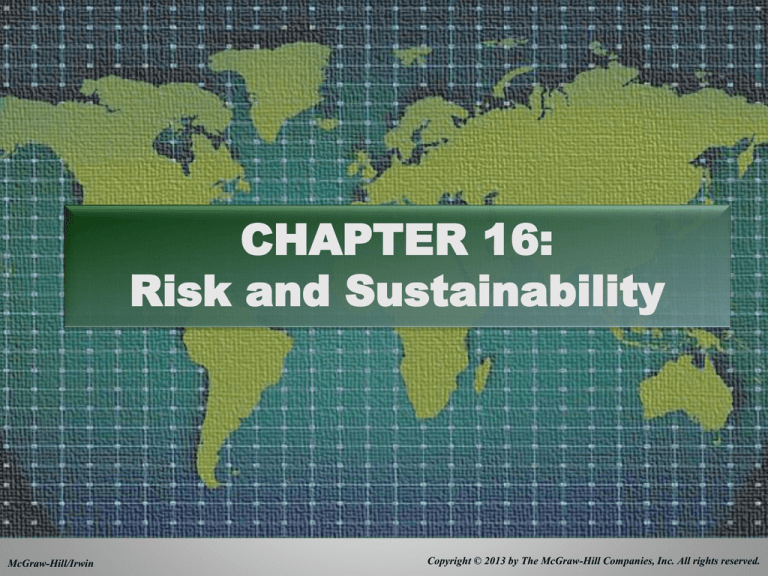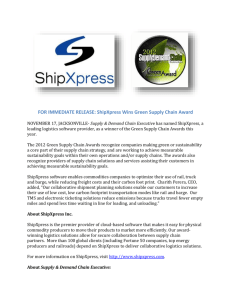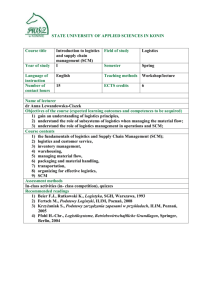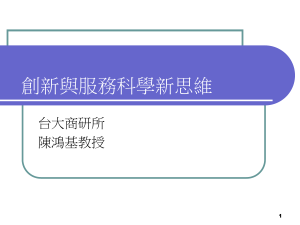
CHAPTER 16:
Risk and Sustainability
McGraw-Hill/Irwin
Copyright © 2013 by The McGraw-Hill Companies, Inc. All rights reserved.
Overview of supply chain risk and
sustainability
• Evolving responsibilities of
supply chain professionals
• Processes and resources
• Risk and security
management
• Sustainability
16-2
Supply chain risks have increased to
support business strategies
• Balanced scorecards had
expanded supply chain
performance measures to
include return on assets and
revenue
• New production introductions
amount to 25% of all item
volume shipped each year
• Sustainability of business
operations is critical and led
to more long-term focus in
strategy development
16-3
Evolving Responsibilities of Supply
Chain Professionals
Functions
Procurement
Manufacturing
Logistics
Figure 16.1 – Evolving Responsibilities of Supply Chain Professionals
16-4
Evolving Responsibilities of Supply
Chain Professionals
Functions
Procurement
Process and
Resources
Manufacturing
Logistics
Figure 16.2 – Evolving Responsibilities of Supply Chain Professionals
16-5
Evolving Responsibilities of Supply
Chain Professionals
Functions
Procurement
Manufacturing
Process and
Resources
Risk and
Security
Logistics
Figure 16.3 – Evolving Responsibilities of Supply Chain Professionals
16-6
Evolving Responsibilities of Supply
Chain Professionals
Functions
Procurement
Manufacturing
Process and
Resources
Risk and
Security
Sustainability
Logistics
Figure 16.4 – Evolving Responsibilities of Supply Chain Professionals
16-7
Processes and resources
• Product complexity
• Outsourcing
16-8
Product complexity is the number of product
design variations a firm offers and supports
• Increased complexity results in
higher supply chain cost
– More inventory, fewer economies
of scale and more management
attention
• Increase complexity often
results in increased revenue
– May improve profitability and
asset utilization
• Less complexity (aka more
commonality) reduces supply
chain costs
– E.g. Toyota has only two variants
for auto door latches while
competitors have over 10
• Reduced product variations
may lower sales
– Firm’s offerings are less attractive
with fewer features or
characteristics
16-9
Variation typically results in higher supply chain
costs, but more choice for customers
Table 16.1 Benefits of Low Complexity
Table 16.2 Characteristics of High Complexity
16-10
How do we balance complexity with profit?
Over what time period?
Figure 16.5 Complexity and Profitability
16-11
Table 16.2 – Measureable benefits from use
of 3PLs
BENEFIT
CHANGE
Logistics cost reduction
15%
Logistics fixed asset reduction
25%
Inventory cost reduction
11%
Average order cycle length
Reduced from 17 to 12 days
Average order fill rate
Increased from 73 to 81 percent
Average order accuracy
Increased from 83 to 85 percent
16-12
Figure 16.4 – Types of services outsourced
to logistics integrators
Outsourced Logistics Service
Domestic transportation
International transportation
Warehousing
Customs brokerage
Forwarding
Cross-docking
Product labeling, packaging, assembly, kitting
Reverse logistics (Defective, repair, return)
Transportation planning and management
Freight bill auditing and payment
Information technology (IT) services
Supply chain consultancy services provided by 3PL
Order entry, processing, and fulfillment
Fleet management
Customer service
Lead logistics provider/4th party logistics services
Percent of
Respondents
Outsourcing
83
75
74
58
53
38
36
35
31
28
20
18
16
15
13
13
16-13
Outsourcing is a risk management technique
• Use of third-party logistics (3PL) firms or logistics
integrators to provide services on a contractual basis
– 3PL providers offer integrated transportation and warehousing
services
– Integrated service providers
• Solicit and coordinate logistics services
• Provide resource management expertise
• Shift risk of a supply chain activity to an outsourcing partner
with expertise
• Pooling capacity across clients results in a lower risk of not
being able to meet customer demands in a surge
16-14
Regulations can promote or constrain
supply chain activities
• Promote activity
– Encourage certain work in a
specific country/region by
providing financial or tax
incentives
• Constrain activity
– Limit types of activities that can
be done in a country/region to
reduce impacts
• Some examples
– Environmental
– Financial and taxation
16-15
Risk and security management
• Regulation
• Financial and taxation
• Security
16-16
Environmental regulation supporting
green initiatives has increased
• Green initiatives include
regulations and activities
to directly reduce the
supply chain’s impact on
the environment
• Examples
– Federal government
mandate to reduce harmful
vehicle emissions
– WalMart effort with
suppliers to reduce
packaging waste
– Dow Chemical redesign of
supply chain to reduce
environmental impact
16-17
Recycling initiatives are experiencing
renewed growth
• Numerous US states
encourage container
returns by requiring
deposits for consumer
beverage containers
• Wastes of Electric and
Electronic Equipment
(WEEE) legislation passed
in European Union
• How active should a firm
be in promoting recycling
initiatives through public
policy?
• Who should design the
reverse logistics systems?
– Public policy and
legislators?
– Private enterprise?
– Requires recycling of
electronic waste
16-18
Financial and taxation incentives are increasingly
important in supply chain design
• Property taxes
– Tax holiday waives taxes on
property, equipment and/or
inventory for a defined period or
permanently
• Income taxes
– Countries with lower corporate
tax rates are more attractive
• Value-added taxes (VAT)
– Taxes only the value added to a
product while in that country
– E.g. Ireland VAT reduction for
electronics and pharmaceutical
industries
16-19
Tax aligned supply chain (TASC)
• TASC aims to help firms
achieve a favorable worldwide
tax rate
• Two supply chain strategies
are common
– Central entrepreneur strategy
• Centralize key functions and
risks in a low-tax country
– Incremental strategy
• Consider tax implications of
each supply chain change
• Probable duration of tax
incentives must be carefully
evaluated
16-20
Security of supply chains is more critical
with global operations
• Developing a secure
supply chain
• Rationale for supply chain
protection
• Cross-border operations
16-21
Developing a secure supply chain
• Supply chain security is
– the application of policies,
procedures, and technology
– to protect assets, product,
facilities, equipment, information
and personnel
– from theft, damage, or terrorism
– and to prevent the introduction to
the supply chain of unauthorized
contraband, people, or weapons
of mass destruction
16-22
Supply chains need to be secure and
resilient
• Resiliency is the ability of the supply chain to
withstand and recover form an incident
• Resilient supply chains
– Are proactive in anticipating and establishing steps
to prevent and respond to security incidents
– Can quickly rebuild or reestablish alternative means
of operations when they experience a security
incident
16-23
Rationale for supply chain protection
• Proactively enhance supply chain resiliency against
terrorism
• Consequences of supply chain security failures
– Terrorist attack causes widespread disruption to customer
delivery capabilities
– Reduced brand equity if customers believe attack was due to
neglect
– Loss of revenue leads to loss of investor confidence and sale of
stock
– Disruption could increase regulatory scrutiny
– Terrorist attack could result in significant legal liability
16-24
Enhancing security is driven by two key
factors
• Brand protection is the primary reason
– Fear product contamination will damage customer perceptions
– Firms now require greater security from their suppliers with
initiatives such as quality certification programs, audits, the
Customs-Trade Partnership Against Terrorism (C-TPAT)
• Government pressure is another factor
– Bioterrorism Act of 2002
• Firms engaged in food processing must be able to trace raw materials and
finished goods one step up and one step down the supply chain
– “Country of origin labeling” (COOL) guidelines have been
developed for some agricultural and food products
16-25
The security framework identifies 10 core
competencies that firms must develop
Table 16.5 Supply Chain Security Competency Definitions
16-26
Table 16.6
Examples of Security Best Practices
Competency
Process Strategy
Process Management
Infrastructure Management
Communication Management
Management Technology
Corporate Example
Senior management believes that supply chain security is critical for consumer and brand
protection
Firm has cross-functional representation on senior level security crisis management team
Management support for security consciousness is indoctrinated through ongoing training
Defined procedures to complete product recalls
Standardized procedures to control receipt and shipment of product
Applies Hazard Analysis and Critical Control Point (HACCP) system
Application of gates, locks, access controls, and guards to restrict access to sensitive
areas
Application of monitoring equipment to detect unauthorized activity
Controls for non-employees to limit access to facilities and operations
Incorporates modules on preventing contamination/security incidents into employee
training
Establishes defined communication protocols in case of a contamination/security incident
Established defined reporting protocols in case of a contamination/security incident
Able to quickly share information with employees in case of a contamination/security
incident
Secure information systems
Ability to track transactions by origin, destination, date, description, and route
16-27
Table 16.6 (cont.)
Examples of Security Best Practices
Competency
Process Technology
Metrics
Relationship Management/Service
Provider Collaboration
Management
Public Interface Mgmt
Corporate Example
Ability to track and trace commodities and products up and down one stage in the supply
chain
Ability to track salvage and returned products
Transportation assets are sealed while not under control of the firm
Measures to track and monitor vulnerable areas (e.g., products, facilities, supply base)
Supply chain security metrics are based on a combination of internal, industry, and
government guidelines
Applies external audits (as opposed to self-audits) to verify security procedures
Maintains a database of emergency contact information for service providers
Requires service providers to use government or industry security guidelines
Complies with government-required record keeping regulations regarding threats and
incidents
Establishes communication strategy for providing information regarding
contamination/security incidents to appropriate government/public agencies
16-28
Security competencies
• Security competencies are
created through
development of security
capabilities such as
–
–
–
–
• Examples of how firms are
applying security
competencies are listed in
Table 16.6
Infrastructure
Processes
Assets
Resources
16-29
Cross-border operations require firms to
• Refine internal processes
– Self-appraisal of security and
contingency planning
– Develop crisis management
plans using cross-functional
teams
• Refine governmental
relationships
– Notion of “trusted partner” must
develop on a global platform
– Which countries are secure?
• Refine collaborative
relationships with partners
– Trusted partner status of firm and
country
– Requires demonstration of trust
to secure product when in
partners control
16-30
Governments promote economic growth
through international trade
• Governments are responsible
for
– Facilitating the movement of
people and goods across borders
– Safety of people, commerce and
country
• Traditional focus of
government agencies has been
control of trade
• Contemporary focus is shifting
to trade facilitation and
securing supply chain
operations with trusted partner
countries
16-31
Customs-Trade Partnership Against
Terrorism (C-TPAT)
• Certify known shippers through selfappraisals of security procedures coupled
with customs audits and verifications
• For a more detailed discussion regarding
C-TPAT visit
http://cbp.gov/xp/cgov/trade/cargo_securit
y/ctpat/what_ctpat/
16-32
Container Security Initiative (CSI)
• Pre-screening of containers coupled with fast
tracking when cargo reaches the U.S.
• A more detailed description of the CSI can be
found by visiting
http://www.cbp.gov/xp/cgov/trade/cargo_secur
ity/csi
16-33
US government security initiatives
impacting ocean, air, rail or truck cargo
• Advanced Manifest Rule (AMR)
– Requires detailed cargo data before shipping to or from the U.S.
• Examples of how AMR has influenced border operations
– http://www.cbp.gov/xp/CustomsToday/2004/March/Other/rules_cargose
curity.xml
• Advanced Cargo Information (ACI)
– Requires more detailed information prior to acceptance into U.S.
• Free and Secure Trade (FAST)
– Allows low-risk goods transported by trusted carriers for trusted
firms to pass rapidly through border crossings
• For a more detailed discussion, visit
http://www.cbp.gov/xp/cgov/trade/cargo_security/ctpat/fast/
16-34
Global organizations are also working
on security initiatives
• International Organization for
Standardization (ISO) and
Strategic Council on Security
Technology
– Smart and Secure Tradelanes
(SST) initiative
• Technology platform to track
containers globally and
generate chain-of-custody audit
trails
• World Customs Organization
(WCO)
– 161 member countries involved
in the Global Standards for
Supply Chain Security Initiative
• World Trade Organization
(WTO)
– Seeks to facilitate trade moving
controls and inspection to the
export stage
– For more information on this
industry driven initiative select
the URL link
» http://www.scst.info
16-35
Resource availability is a substantial risk for
global supply chain operations
• Changes in availability of
resources dramatically
changes supply chain
design and operations
• Key resources include
– Supply chain expertise
– Transport capability
• Outsourcing is one method
of managing this risk
16-36
Figure 16.6
Dimensions of Sustainability
Economic
Ethics
Offsets
Free
Trade
Substitutes
Wages &
Benefits
Lean
Collaboration
Energy
Financial
Taxation
Geo-Politics
SUSTAINABILITY
Risk
Security
Waste
Life Cycle
Conservation
Environment
Elimination
Social
Responsibility
Technology
Usage
Communication
Cultural
Awareness
Global
Knowledge
Talent
Development
Education
Source: David J. Closs, Cheri Speier, Nathan Meacham. “Sustainability to support end-to-end value chains: the role of supply chain
management.” Journal of the Academy of Marketing Science 39:1 (February 2011). Pg. 103.
16-37
Environmental sustainability initiative
examples
Environmental
Conservation
Usage
Reduction
Business
Practices
Energy
Waste /
Recycling
Packaging
Water
Green House
Gasses
Facility
Construction
Nature
End of Life
Management
Sustainable
Sourcing
16-38
Ethical Sustainability Initiative
Examples
Ethics
Employee
Relations
Community
Involvement
Business
Practices
Code of Conduct
Avoiding
Child/Forced
Labor
Product Safety
Volunteerism
Disaster Relief
Responsible
Marketing
Reducing Hunger,
Poverty, and
Disease
Product
Traceability
16-39
Education sustainability initiative examples
Education
Employee
Relations
Community
Involvement
Business
Practices
Talent
Development
Workplace
Safety
Community
Outreach
Supplier
Training
Diversity &
Inclusion
Flexible
Hours
Sustainable
Workforce
Business
Continuity
Training
Healthy
Lifestyle
16-40
Economic sustainability initiatives examples
Economic
Internal
Management
External
Management
Modal Shift
Supplier
Management
Transportation
Optimization
Market
Generation
Continuous
Improvement
Fuel
Conservation
16-41
Supply chain sustainability examples
•
•
•
•
•
Supply chain talent management
Experience and credibility
Changes in fuel prices
Environmental regulation
Sustaining the global supply chain
16-42
A profile of a supply chain executive
• Evaluate and make tradeoffs between supply chain
functions, other functions
and external organizations
• Develop and implement
integrated and
comprehensive supply
chain solutions
• Share knowledge and
experience to help
business partners in their
supply chain efforts
• Analyze the overall
business performance to
facilitate sustainable
competitive advantage
16-43
Supply chain expertise is particularly
important in two areas
• Cross-functional expertise
regarding breadth of supply
chain functionality
– Customer accommodation,
procurement, logistics, and
manufacturing
• Broad and deep expertise in
global requirements and
individual country operations
• Development and retention of
supply chain executives is one
method to manage this risk
– Provide potential executives with
opportunities and guidance to
develop job skills that will lead to
success
16-44
Supply chain management executives must have
skills and capabilities in these areas
• Functional
– Procurement, transportation, demand/supply
planning, inventory, manufacturing, global operations
and customer fulfillment
• Technical
– Ability to apply information technology solutions
effectively
• Leadership
– Lead projects in complex, matrixed business
environments
– Communication, negotiation, problem solving, team
leadership and project management
16-45
Supply chain management executives must have
skills and capabilities in these areas
• Global management
– Global planning and operations experience
– Experience working outside of home country
• Experience and credibility
– Ability to evaluate the competitive environment,
conceptualize strategy, assess solutions, and
implement change
16-46
Traditional Supply Chain Career Path:
Functional Depth
Executive
Level
Senior Level
Advisory
Level
ISC Staff
Level
Demand/Supply
Planning
ISC Entry
Level
Procurement
Manufacturing
Global Logistics
Fulfillment
Traditional Career Paths
16-47
A range of learning opportunities is needed to
develop today’s supply chain professional
SCM
Consulting
Level
SCM
Senior Level
SCM
Advisory
Level
N/A
ISC Staff
Level
N/A
ISC Entry
Level
Demand/Supply
Planning
Procurement
Manufacturing
Global Logistics
Traditional Career Paths
Fulfillment
Supply Chain
Management
Sample SCM Career Paths
Figure 16.7 Cross-functional supply chain career paths
16-48
SCM job titles and associated
criteria
“ADVISORY” LEVEL
Career Level
Advisory Supply Chain
Management Professional
Advisory &
Senior level
SCM
categorization
completed by
employee’s
manager
Experience
Typically
7-8 years
Criteria
-
Advisory Supply Chain
Management Professional
- Manager
Senior
Supply Chain Management
Professional
-
Typically
10-13 years
-
-
“SENIOR” LEVEL
Senior Supply Chain
Management Professional
- Manager
-
Consulting
level SCM
categorization
completed via
SCM
application &
Review Board
process
Experience in at least two supply chain functional disciplines
Direct working experience or supply chain related working knowledge of S&D, IGS/BCS,
brands, etc. within IBM or similar experience outside IBM
Demonstrate proficiency in applicable skills as defined in the SCM skills proficiency
guidelines.
Prove business contribution (operations and/or significant benefit from transformation
reflected by key business measurements)
Active membership in a relevant professional association
Experience in at least three different supply chain functional disciplines, including one role
that spans several processes (such as a job in strategy, business development,
transformation, etc.)
Demonstrate higher proficiency in applicable skills than advisory level
Ability to provide supply chain management consulting (internal or external)
Client engagement experience
Multi-country experience and/or global impact
Recognized resource of supply chain expertise
Contribute to IBM’s intellectual capital
Ability to build organizational capability (e.g. recruiting, mentoring, training)
Proven field knowledge (by completing course work, studying industry journals or
attending conferences)
Participate in Profession sponsored activities in IBM
Active membership in relevant professional associations
Experience in at least three different supply chain functional disciplines, including two
roles that span several processes (such as a job in strategy, business development,
transformation, etc.)
Experience in supply chain solutions including software and services
Demonstrate higher proficiency in applicable skills than senior level
Ability to provide supply chain management consulting (internal or external)
Recognized for business impact at the senior executive level (significant contribution in
operations and/or transformation reflected by key business measurements)
Significant client engagement experience
Demonstrate knowledge (e.g. advanced degree, case study, passed exams, external
certification)
External professional contribution (e.g. publication, patent, conference presentation,
leadership position in relevant professional association)
Active membership in relevant professional associations
Consulting Supply Chain
Management Professional
Consulting Supply Chain
Management Professional
- Manager
Typically
12-16 years
-
“CONSULTING” LEVEL
-
16-49
Transport capability is impacted by the
volatility of fuel prices
• Diesel fuel represents 30% of
overall transportation cost
Figure 17.6 U.S. Diesel Fuel Prices Since 1994
(in USD per gallon)
– Dramatic shifts in fuel costs require
regular assessments of network
structure and strategy
• Fuel price volatility has two
impacts on supply chain
decisions
– Influences the viability and flow of
global trade
– May change domestic logistics
network
U.S. DIESEL FUEL PRICES SINCE 1999 (in USD
per gallon)
(Source: U.S. Department of Energy)
16-50
Illustration of how doubling the fuel price changes the
least-total-cost network from 7 to 10 centers
Figure 16.9 Optimal Number of Distribution Centers by Fuel Prices
16-51
Supply Chain Dynamics are Changing
• Firms looking for more balance between scale and
reliability.
• Infrastructure congestion is becoming increasingly
problematic.
• Increased energy cost will shift supply chain mode
selection and design.
• Increasing importance of being able to quantify the
value proposition related to supply chain changes.
16-52
Changing Dynamics of Supply Chain
Design
$/unit
Cost of
transport
A
Decentralized
Economies of Scale
Centralized
16-53
Changing Dynamics of Supply Chain
Design
Result of
increased fuel
cost
$/unit
Cost of
transport
B
A
Decentralized
Centralized
Economies of Scale
16-54
Figure 16.10
Changing Dynamics of Supply Chain Design
Result of
increase risk
Result of
increased fuel
cost
$/unit
Cost of
transport
C
B
A
Decentralized
Centralized
Economies of Scale
16-55










